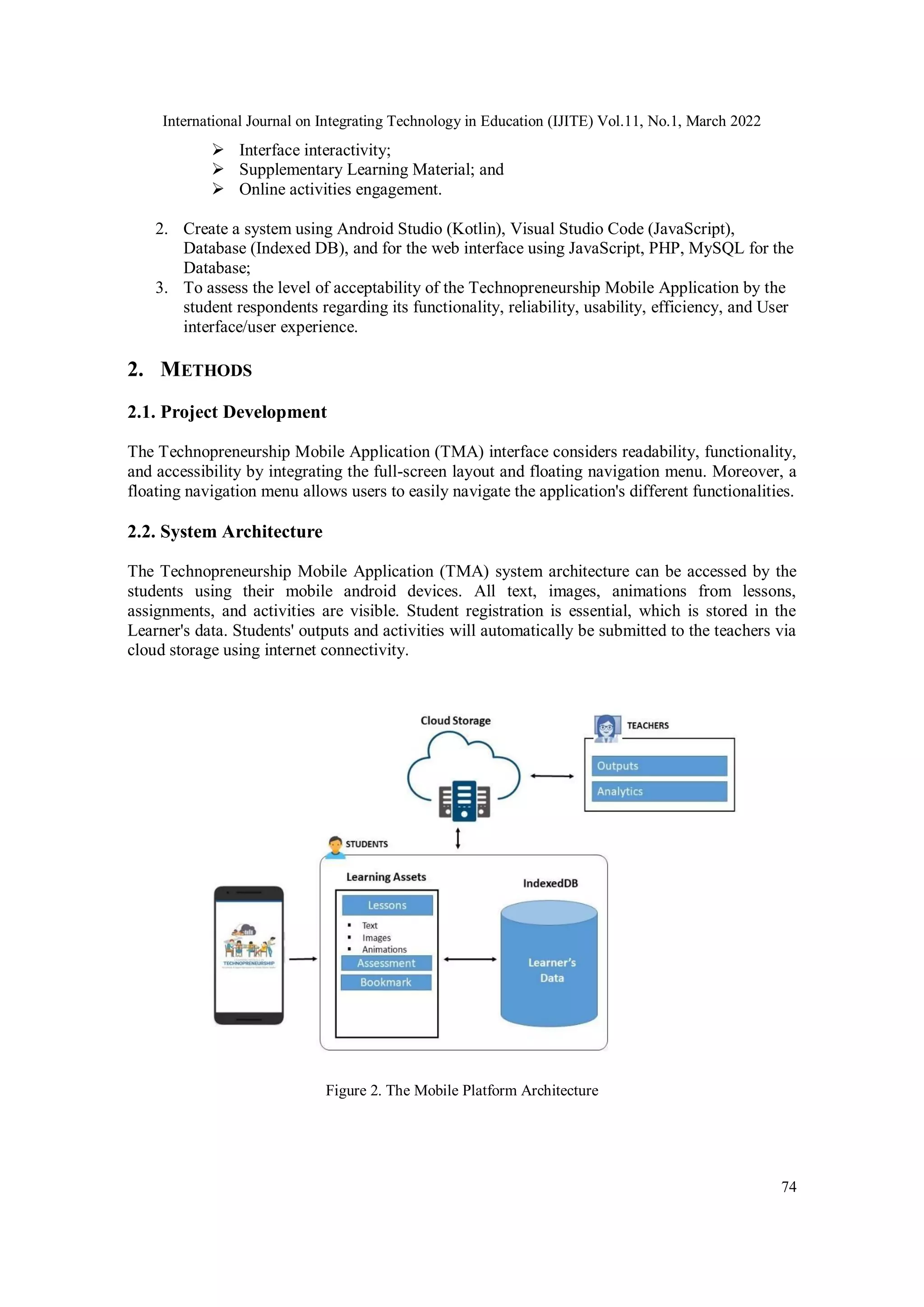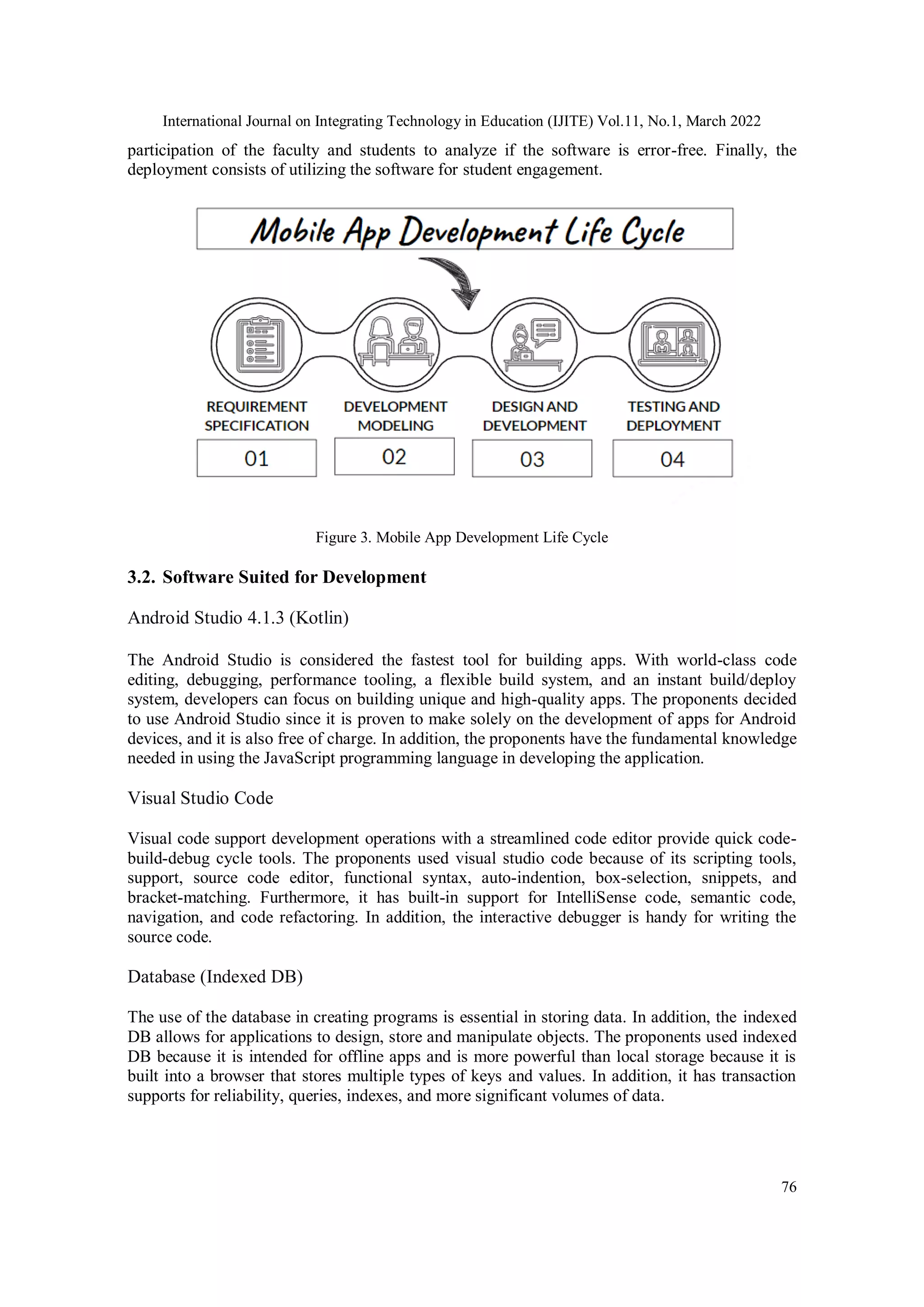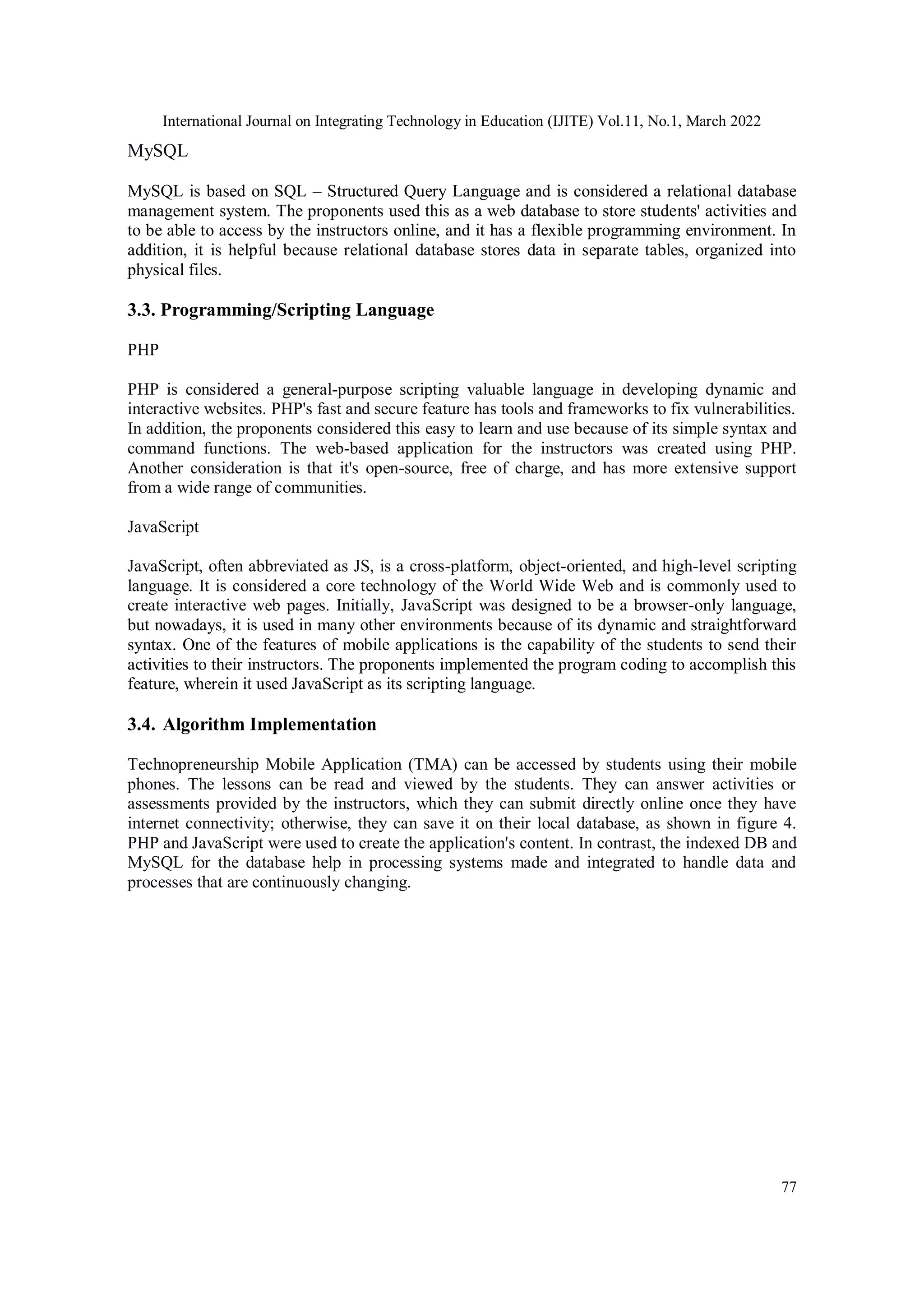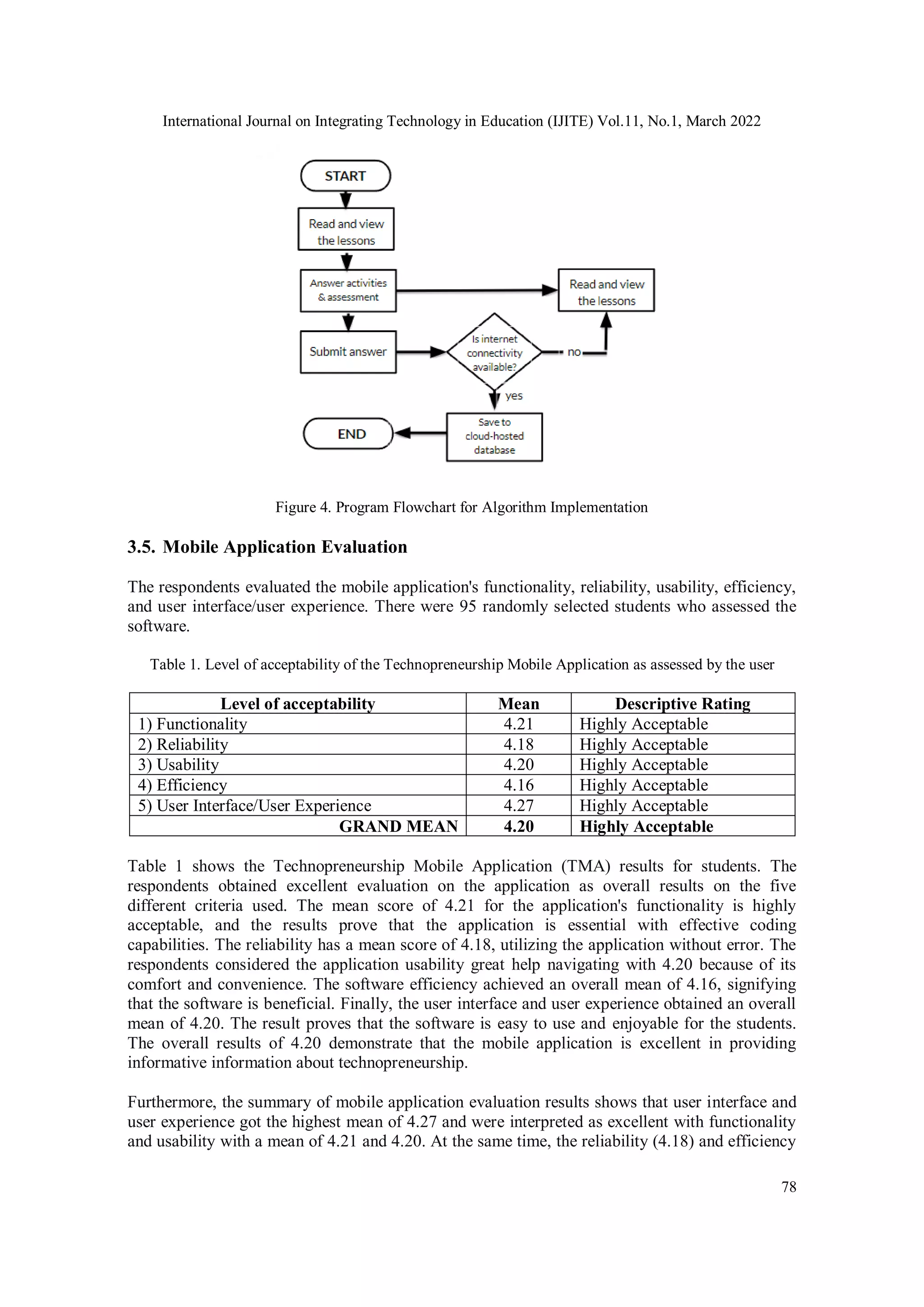- The document describes a study that developed a Technopreneurship Mobile Application (TMA) to support flexible learning delivery for students.
- 95 IT students evaluated the application on functionality, reliability, usability, efficiency, and user interface, giving it an overall excellent rating of 4.20.
- The application was developed using Android Studio, Visual Studio Code, Indexed DB database, and PHP/JavaScript. It allows students to access lessons, submit assignments, and communicate with teachers.
![International Journal on Integrating Technology in Education (IJITE) Vol.11, No.1, March 2022
DOI :10.5121/ijite.2022.11105 71
TECHNOPRENEURSHIP MOBILE APPLICATION
(TMA): A SUPPORT MECHANISM FOR FLEXIBLE
LEARNING DELIVERY SYSTEM
Dr. Maricris M. Usita1
and Ronnie Del Rosario2
1
College of Arts, Sciences, and Technology,
Occidental Mindoro State College, San Jose, Occidental Mindoro, Philippines
2
Department of Information Technology,
Occidental Mindoro State College, San Jose, Occidental Mindoro, Philippines
ABSTRACT
Mobile phones are essential in our daily lives because of their benefits in communication, entertainment,
and education. Students use their mobile phones in teaching-learning engagement, both synchronous and
asynchronous. The study focused on developing and validating Technopreneurship Mobile Application
(TMA) in its functionality, reliability, usability, efficiency, and User interface/user experience. The study
engaged with developmental research using the mobile app development cycle, including requirement
specification, development modeling, design and development, testing, and deployment. Online data
gathering and analysis were used for mobile application validation, evaluation performance, and mobile
deployment. A total of 95 information technology students evaluated the application. The results showed
that the application is functional, reliable, usable, efficient, and the user interface is helpful. The overall
results obtained a 4.20 with an excellent evaluation that shows that developing a mobile application can be
a great tool in the flexible learning delivery for students due to its accessibility and usefulness.
KEYWORDS
Flexible Learning, Mobile Application, Support Mechanism, Technopreneurship, User Interface.
1. INTRODUCTION
Mobile phones have increased their popularity, especially among the younger generation. In
Asia's developing countries, mobile phones facilitated mLearning in helping to enhance
educational outcomes [1]. Smartphones and other mobile devices have great possibilities in
education, given the rapid rise in smartphone ownership among younger age groups and these
devices' teaching and learning benefits [2]. As a result, mobile phone technology continues its
rapid development, and mobile applications have improved information access and the way we
communicate and collaborate [3]. Mobile devices have evolved into a whole suite of applications,
support, and assistance for educational institutions. Mobile devices can produce practical
educational applications for present students [4].
Similarly, mobile phones are being used to teach and learn in the educational sector. Mobile
phones are considered an integral part of college life and used overtly and covertly in a campus
setting, most significantly inside the classroom. Students can access or download learning
materials on their smartphones and tablets, install educational apps, and study whenever and
wherever they want [5]. A smartphone is a phone and a device that can educate you with your](https://image.slidesharecdn.com/11122ijite05-220423084456/75/Technopreneurship-Mobile-Application-TMA-A-Support-Mechanism-for-Flexible-Learning-Delivery-System-1-2048.jpg)
![International Journal on Integrating Technology in Education (IJITE) Vol.11, No.1, March 2022
72
willingness and timing conveniently available for the user [6]. The device appears capable of
contributing to student learning and improved academic performance.
Mobile devices significantly influence education and experience continuous transformation and
adoption. Although using mobile phones in the classroom can be difficult, multiple studies have
shown that using wireless networks and mobile applications to facilitate collaborative learning
can improve educational outcomes [7].
Mobile learning is a new platform of learning through mobile technologies, and it has increased
the penetration of smartphones and digital devices globally in a short interval of time [8]. There is
a diverse learning opportunity for using M learning because the mobile phone is portable, has
social interactivity, context sensitivity, connectivity, individuality, and affordance to people in
academic or non-academic settings [9].
Likewise, mobile learning arouses interest and helps the students acquire a better understanding
of other materials. Learners seemed to value those learning activities to apply learned knowledge
and skills to personal situations. Mobile learning is an emerging trend that brings advantages to
learners in achieving their goals [10]. M-learning converts mobile applications into more diverse
and provide accurate information available according to the need of students. The learners are
more comfortable downloading the app, using it according to the condition, and sharing ideas and
views. M-learning allows learners to engage with the learning processes in various locations,
through a range of devices, and at a time of convenience [11].
In addition, Mobile learning allows students to study, collaborate, and exchange ideas while
using the internet and technology, which lead to a significant component in higher education
[12]. The use of instructional apps has increased students' competencies in relational and
communicative skills [13]. On the other hand, mobile learning enhances students' learning, and
engagement improves communication between participants and provides authentic and situated
learning. The results also revealed that mobile technologies positively change the modes of
teaching and learning in the field of education, which speedup its use and implementation in the
education sector [14].
Moreover, educational techniques are changing very quickly. Recent advancements in technology
challenge the present educational system to develop a program that meets an ever-changing
society's demands. Educational apps promote active, engaged, meaningful, and socially
interactive learning [15]. Educational institutions are increasingly transitioning to mobile
platforms and mobile application technology to communicate, advertise, and disseminate
education-related information [16]. Educators are then obliged to prepare the students for an
increasingly technological society that will require them to search for new techniques and
strategies to maximize learning. The teaching model of mobile learning can help college students
get a better learning experience that can significantly improve students' learning effectiveness,
skill mastery, and learning enthusiasm [17].
Furthermore, Occidental Mindoro State College has implemented two learning modalities since
2020: flexible learning delivery and modular learning. Students are now using mobile phones to
engage with their teachers by accessing their google classroom, video conferencing, and
communicating through Facebook, email, and messenger. The use of mobile technologies to
increase learning opportunities outside the school is urged by higher education teachers [19].
Finally, the Technopreneurship Mobile Application (TMA) is a great help to facilitate
interactions between students and teachers in the most accessible way. Smartphones have
emerged to assist both teachers and students in improving the quality of learning. The mobile](https://image.slidesharecdn.com/11122ijite05-220423084456/75/Technopreneurship-Mobile-Application-TMA-A-Support-Mechanism-for-Flexible-Learning-Delivery-System-2-2048.jpg)
![International Journal on Integrating Technology in Education (IJITE) Vol.11, No.1, March 2022
73
technology will be utilized as a platform in delivering the M learning modalities of students.
These mobile technologies are not only helping learners to develop new media aptitudes, but they
also extend the opportunity for learners and instructors to create stronger links [20].
Lastly, to help improve students' access, resources, and performance in the subject of
Technopreneurship. With the Mobile application development, the students can access the
lessons even with limited internet connectivity. The lessons are complete and accommodate a
small amount of storage with their mobile phone which provides an opportunity to have an
alternative way of reaching out to students following the availability of their resources. A mobile
application environment with appropriate content promotes the students' scientific, analytical, and
critical thinking abilities. User experience testing revealed how the TMA application is used, its
challenges, and its process of improvement and development. The user experience is useable,
helpful, desirable, and low cost [21].
1.1. Research Paradigm
Figure 1. IPO Diagram for Users
The Input-Process-Out (IPO) diagram shows the informational and graphical representation of
how data is being processed to produce results. Figure 1 shows the conceptual process of the
application. TMA lets the users register in the application to have valid access. The user can only
view the topics options and menus to access the lessons, activities, and assessments. The
application provides an interface where users can easily access and send their tasks and activities.
1.2. Objectives of the Study
The study's main objective is to develop and evaluate a Technopreneurship Mobile Application
(TMA): A Support Mechanism for Flexible Learning Delivery System.
Specifically, this study aims to achieve the following objectives:
1. Develop an appropriate Technopreneurship Mobile Application with the following
features:
Well represented digital information;](https://image.slidesharecdn.com/11122ijite05-220423084456/75/Technopreneurship-Mobile-Application-TMA-A-Support-Mechanism-for-Flexible-Learning-Delivery-System-3-2048.jpg)

![International Journal on Integrating Technology in Education (IJITE) Vol.11, No.1, March 2022
75
2.3. Research Design
The researcher uses the descriptive research method utilizing the developmental study to attain
the desired evaluation of the acceptability and effectiveness of the Technopreneurship Mobile
Application. This study utilizes the descriptive research method through the survey technique
done using google Forms. The evaluation seeks the respondent's permission and informs them
about the conduct of the research. The questionnaires used in the data gathering involved the
system's development.
2.4. Respondents
The respondents of this study were the ninety-five (95) Information Technology students who are
currently enrolled and joining online classes. The application was developed for the students to
access the module in Technopreneurship easily.
2.5. Instrument
The proponents used online survey questionnaires to collect the necessary information from the
respondents of this study. The questions in the survey were divided into five criteria, namely: (1)
Functionality, (2) Reliability, (3) Usability, (4) Efficiency, (5) User Interface/User Experience,
which were then subdivided into three questions per criteria. The questionnaire used the Likert
scale format, where respondents rated the app, five being the highest and one being the lowest.
The respondents prepared a google form to select an option from the given criteria easily. The
survey questionnaire was presented clearly and only required the respondents to choose an option
corresponding to their rating score. Furthermore, the respondents wrote comments or suggestions
about the application's accuracy and execution.
2.6. Data Gathering Procedure
The following sections explain the evaluation results of the students of BSIT 1st year (AY 2021-
2022) of Occidental Mindoro State College, particularly from Bachelor of Science in Information
Technology.
3. RESULTS
3.1. Mobile Application Development Life Cycle
The study is created following the mobile application development life cycle. Figure 3 shows the
software's components from requirements specification, development modeling, design and
development, and testing and deployment. The requirement specification is identified based on
the students' availability of resources currently used. The navigation and functional requirements
of the software are under the student's capabilities. Identifying its purpose, needs, context, and
content is essential to achieving the project objective. High quality of service (QoS) and minimal
latency is required for real-time mobile applications such as online gaming, audio/video
conferencing, and financial transactions [22].
After analyzing and identifying the requirements, the AGILE development model is suited for
this application. At the same time, the design includes the software's interface, including its
navigational functionality. The development focuses on customizing the software with proper
coding, database, and web application integration without any errors. The testing includes the](https://image.slidesharecdn.com/11122ijite05-220423084456/75/Technopreneurship-Mobile-Application-TMA-A-Support-Mechanism-for-Flexible-Learning-Delivery-System-5-2048.jpg)



![International Journal on Integrating Technology in Education (IJITE) Vol.11, No.1, March 2022
79
(4.16) were considered good. Therefore, the software is a useful mobile application in flexible
learning delivery that helps students interact, communicate, share information and resources.
4. CONCLUSIONS
In conclusion, the proponents were able to meet their research requirements. They made the
application function well regarding access and easy utilization of the students with the Mobile
Application on Technopreneurship. As a result, TMA got positive results in the evaluation
conducted involving the Information Technology students. The application could view lessons
and activities most conveniently, and they can answer and send their activities using the mobile
app.
TMA was able to help students and faculty to easily communicate about the lessons interact with
the images, buttons, and navigation tool. The search feature with easy access to the lesson makes
it easier to use. The proponents conceptualized the application to be easy to understand. Most
respondents agreed that they could quickly learn how the application works and use it without
much effort. The application is helpful for students in the delivery of flexible learning
engagement. The students can easily view the lessons at any time, even without internet
connectivity. The review function works positively, where students can submit their tasks online.
ACKNOWLEDGMENTS
The authors would like to thank the Occidental Mindoro State College Administration, College of
Arts, Sciences, and Technology faculty, students, families, and friends.
REFERENCES
[1] J. H. Valk, A. T. Rashid, and L. Elder, “Using mobile phones to improve educational outcomes: An
analysis of evidence from Asia,” Int. Rev. Res. Open Distance Learn., vol. 11, no. 1, pp. 117–140,
2010, doi: 10.19173/irrodl.v11i1.794.
[2] W. Fatimah and W. Ahmad, “Designing a Mobile Application for Children : Space Science.”
[3] D. M. D. Oliveira, L. Pedro, and C. Santos, “Measuring the Use of Mobile Applications in Higher
Education,” no. November, pp. 1–11, 2021, doi: 10.4018/978-1-7998-8193-3.ch001.
[4] S. Criollo-C, A. Guerrero-Arias, Á. Jaramillo-Alcázar, and S. Luján-Mora, “Mobile learning
technologies for education: Benefits and pending issues,” Appl. Sci., vol. 11, no. 9, 2021, doi:
10.3390/app11094111.
[5] S. A. Shonola and M. Joy, “Enhancing Mobile Learning Security,” Int. J. Integr. Technol. Educ., vol.
5, no. 3, pp. 01–15, 2016, doi: 10.5121/ijite.2016.5301.
[6] M. Kearney, S. Schuck, K. Burden, and P. Aubusson, “Viewing mobile learning from a pedagogical
perspective,” Res. Learn. Technol., vol. 20, no. 1, p. 14406, 2012, doi: 10.3402/rlt.v20i0.14406.
[7] D. Blasco, “Student’s Attitudes Toward Integrating Mobile Technology Into Translation Activities,”
Int. J. Integr. Technol. Educ., vol. 5, no. 1, pp. 01–11, 2016, doi: 10.5121/ijite.2016.5101.
[8] M. I. Qureshi, N. Khan, S. M. Ahmad Hassan Gillani, and H. Raza, “A systematic review of past
decade of mobile learning: What we learned and where to go,” Int. J. Interact. Mob. Technol., vol.
14, no. 6, pp. 67–81, 2020, doi: 10.3991/IJIM.V14I06.13479.
[9] H. Crompton, “Mobile Learning: New Approach, New Theory,” Handb. Mob. Learn., no. January
2013, pp. 85–95, 2020, doi: 10.4324/9780203118764-12.
[10] G. Sun and J. Shen, "Facilitating social collaboration in mobile cloud-based learning: A teamwork as
a service (TaaS) approach," IEEE Trans. Learn. Technol., vol. 7, no. 3, pp. 207–220, 2014, doi:
10.1109/TLT.2014.2340402.
[11] A. C. Jones, E. Scanlon, and G. Clough, “Mobile learning: Two case studies of supporting inquiry
learning in informal and semiformal settings,” Comput. Educ., vol. 61, no. 1, pp. 21–32, 2013, doi:
10.1016/j.compedu.2012.08.008.
[12] U. Alturki and A. Aldraiweesh, “Students’ Perceptions of the Actual Use of Mobile Learning during](https://image.slidesharecdn.com/11122ijite05-220423084456/75/Technopreneurship-Mobile-Application-TMA-A-Support-Mechanism-for-Flexible-Learning-Delivery-System-9-2048.jpg)
![International Journal on Integrating Technology in Education (IJITE) Vol.11, No.1, March 2022
80
COVID-19 Pandemic in Higher Education,” Sustain., vol. 14, no. 3, 2022, doi: 10.3390/su14031125.
[13] A. C. Camilleri and M. A. Camilleri, “Mobile learning via educational apps: An interpretative study,”
ACM Int. Conf. Proceeding Ser., pp. 88–92, 2019, doi: 10.1145/3337682.3337687.
[14] H. Maulana, U. Muhammadiyah, and S. Utara, “Analysis of the Effectiveness of Online Learning
Using Eda Data Science and Machine Learning,” vol. 7, no. 1, pp. 222–231, 2022.
[15] K. Hirsh-Pasek, J. M. Zosh, R. M. Golinkoff, J. H. Gray, M. B. Robb, and J. Kaufman, Putting
Education in “Educational” Apps: Lessons From the Science of Learning, vol. 16, no. 1. 2015.
[16] B. Esanov and A. Dahanayake, “Personalized Virtual Campus Journey Adaptation to User Controlled
Experience,” vol. 0, 2022, doi: 10.3233/faia210494.
[17] X. Zhang, “The Influence of Mobile Learning on the Optimization of Teaching Mode in Higher
Education,” vol. 2022, 2022.
[18] K. De Beckker, K. De Witte, and G. Van Campenhout, “Identifying financially illiterate groups: An
international comparison,” Int. J. Consum. Stud., vol. 43, no. 5, pp. 490–501, 2019, doi:
10.1111/ijcs.12534.
[19] H. Crompton and D. Burke, “The use of mobile learning in higher education: A systematic review,”
Comput. Educ., vol. 123, no. September 2017, pp. 53–64, 2018, doi: 10.1016/j.compedu.2018.04.007.
[20] S. Pulla, “Mobile learning and indigenous education in Canada: A synthesis of new ways of
learning,” Int. J. Mob. Blended Learn., vol. 9, no. 2, pp. 39–60, 2017, doi:
10.4018/IJMBL.2017040103.
[21] M. Gaborov and D. Ivetić, “Technical and Educational Sciences jATES The importance of
integrating Thinking Design , User Experience and Agile methodologies to increase profitability,”
vol. 12, no. 1, pp. 1–17, 2022.
[22] S. K. uz Zaman et al., “Mobility-aware computational offloading in mobile edge networks: a survey,”
Cluster Comput., vol. 24, no. 4, pp. 2735–2756, 2021, doi: 10.1007/s10586-021-03268-6.
AUTHORS
Dr. MARICRIS M. USITA
Dean of the College of Arts, Sciences, and Technology of Occidental Mindoro State
College.
Mr. RONNIE DEL ROSARIO
Faculty of the College of Arts, Sciences, and Technology, Information Technology
Department of Occidental Mindoro State College.](https://image.slidesharecdn.com/11122ijite05-220423084456/75/Technopreneurship-Mobile-Application-TMA-A-Support-Mechanism-for-Flexible-Learning-Delivery-System-10-2048.jpg)